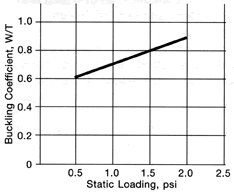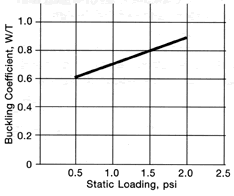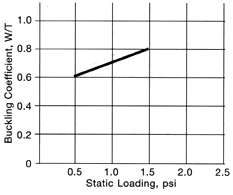Package Design Guide
- Introduction
- Determine Product Fragility
- Determine Conditions
- Calculate Cushion Requirements
- Recognizing Design Constraints
- Design Prototypes and Test
- Consider Vibration Effects
- Monitor Performance
Package Design Guide
STEP FOUR: Recognizing Design Constraints
In most cases, the design approach we used in step three, i.e. using the highest possible static loading, will produce economical designs which adequately protect your packaged product. There are three constraints that must be checked however, to be sure this loading will not create other problems: compressive creep, cushion buckling, and extreme temperature effects.
Consider Compressive Creep
Compressive creep is the gradual loss of thickness a material may experience if placed under a constant load for an extended period of time. Significant compressive creep will result in the packaged product loosening in the cushion and becoming vulnerable to excessive movement inside the package during shipment.
As a general rule, creep of 10% is recognized as a practical upper limit. In some cases creep losses of over 10% in thickness have been shown to result in a significant loss of cushion performance.
Should it be found that creep in excess of 10% is anticipated, designers should recalculate the functional foam requirement using a lower static-loading figure. Spreading the loading over a larger area will reduce compressive creep.
The recommended loading limits to avoid excessive creep for various ETHAFOAM* polyethylene foam products are shown in below. Published dynamic cushioning data on ETHAFOAM cuts cushioning curves off at these limits to prevent you from inadvertently exceeding them.
These limits are believed to be adequate for temperatures encountered in a normal shipping environment. If exposure to excessive temperatures above 120°F are anticipated, lower loadings may be desirable. Consult product data sheets for compressive creep data on individual products.
Recommended Loading Limits for ETHAFOAM Brand Product
| Material | Static Loading Limit |
|---|---|
| ETHAFOAM Nova | 1.5 psi |
| ETHAFOAM Select | 2.0 psi |
| ETHAFOAM 220, 4101, M1 | 2.5 psi |
| ETHAFOAM HS-45, M3 | 5.0 psi |
| ETHAFOAM HS-600, M4 | 10.0 psi |
| ETHAFOAM HS-900, M5 | 20.0 psi |
Consider Cushion Buckling
 |
| Buckling Coefficients for ETHAFOAM 220 at Various Static Loadings |
 |
| Buckling Coefficients for ETHAFOAM Select at Various Static Loadings |
 |
| Buckling Coefficients for ETHAFOAM Nova at Various Static Loadings |
†Typical values, not product pecification limits. Note: for higher strenght, higher density ETHAFOAM products, the use of a constant buckling coefficient (W/T) of 0.75 is recommended. |
Buckling is the non-uniform compression of a cushion. When buckling occurs, the energy of the impact is not transferred evenly throughout the cushion and more shock is transferred to the package contents. Buckling usually occurs when the cushions become too tall and thin.
Buckling is actually less of a problem with ETHAFOAM* products than with many other cushioning materials. Yet it is one more factor you have to consider when designing a package. By using the charts and formulas presented below, you’ll be able to account for buckling in your designs and prevent any potential problems.
The tables help determine when the shape of the cushions can cause non-uniform compression, or buckling. They provide width-to-thickness coefficients for different static loading values and enable the designer to check for buckling potential.
To use the charts, determine the static loading (in psi) your product places on the cushion (divide product weight by surface area). Next, find the static loading value on the horizontal axis of the chart and read up to where the curve crosses it to find the buckling coefficient.
Next, multiply this coefficient by the thickness of the cushion to determine how wide the cushion must be to resist buckling. The example below will help illustrate how the chart and formula are used.
In cases where you must increase bearing area to avoid buckling, this results in decreased static loading. Check to see if this brings you into an appropriate loading range for the next lower strength grade of ETHAFOAM polyethylene foam, as it may be possible to redesign into a lower strength material more economically.
Let’s assume you plan to use a 3-inch thick pad of ETHAFOAM 220 to cushion a side of your product, which presents a static load of 10 psi. You’d refer to Buckling Coefficients for ETHAFOAM 220 at Various Static Loadings, find 1.0 psi along the bottom and follow the vertical line straight up until it intersects the plot line. From this point, follow the horizontal line to the left where you’ll find the W/T coefficient. In this case, the coefficient is 0.7. Using the formula T x W/T = W, you can now find the minimum width: 3"x 0.7 = 2.1". Your cushion must be at least 2.1 inches wide or long to resist buckling.
Note: For higher strength, higher density ETHAFOAM products, the use of a 0.75 buckling coefficient is recommended.
Consider Extreme Temperature Effects
One of the advantages of ETHAFOAM* polyethylene foams is that they retain their properties and characteristics with minimal change over a wide range of temperatures. However, as with all thermoplastic foams, when they are exposed to extremely high or low temperatures over a considerable length of time, they may be affected. The materials become stiffer at low temperatures and increasingly softer at higher temperatures. In extreme cases, it may become necessary to compensate for these effects in your design. Consult the individual product data sheets for ETHAFOAM available data on cushioning performance at extreme temperatures.